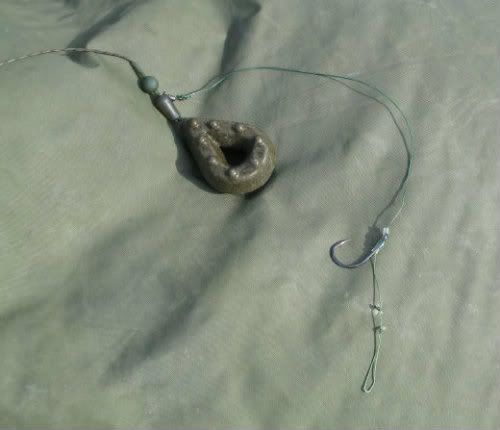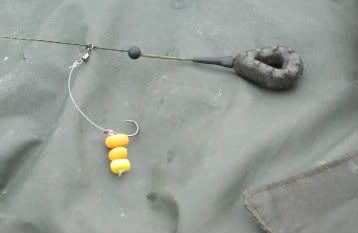
Returning a nice common to the river
Carping on the River – Part 1
By Richard Crimp
“When you are content to be simply yourself and don't compare or compete, everybody will respect you.”
Laozi (Lao Tzu) – 6th century BCE
Fishing the river for carp, in many ways, is no different to fishing anywhere else for the species. There are so many factors outside of your control that, it is all that you can do to increase your percentage chances of catching a fish or two, by simply committing yourself completely to the task at hand and by using as many tools as you are able, to assist you in your goal.
In this, the first part of the summer's carping, I'll try and give those of you that are interested a few pointers as to how I went about the river campaign, thereafter, in Part 2, I'll put up the pictures of the fish caught by myself and Adrian, as well as a little bit of background to each capture, where appropriate.
Tackle
Firstly, I would have no hesitation to advise that a boat will give you a massive advantage over those that are fishing from the bank, for many reasons. Fishing from the bank will restrict you in terms of location, and location is absolutely crucial when you begin to throw hundreds of pounds worth of bait into a river full of bream, dace, crabs, birdlife etc. that will all take advantage of the free offerings you're supplying in bucket loads. When fishing the bank you will also have a far greater chance of turning up and finding someone sitting in the swim you've been baiting, maybe they've been baiting it too? Equally importantly, a boat allows you drop bait 100% where you want the bait to be placed, be that pre-bait or hook-bait, far more quickly and with greater stealth. By 'stealth', I mean from other anglers, as well as your quarry.
More often than not, however, I can almost guarantee that, once you start to catch a fish or two from the bank – and even if you tell no one – mysteriously people always find out? This is usually due to someone seeing you catch fish, baiting up etc. and it doesn't necessarily have to be another fisherman seeing you either, people have angling friends and word gets around very, very quickly.
That said, I've had reasonable successes from the bank and despite the negatives, there are plenty of positives too. Never ignore the margins, so many cast to the sun, it is rarely necessary if you've done your homework.
This summer I have been using my 3.25 Harrison Chimeras, Daiwa Emblem Exceler reels, 22lb Berkley Big Game/Carp as my mainline, ESP Leadcore in 6' lengths.
The landing net is quite an important issue on a river, the mesh needs to be large enough to allow moving water to pass through fairly easily, nothing worse than seeing a fish close to landing and having your net being pulled away by the force of the water.
I use a sack on the river sometimes. It's not often used when I'm fishing in company, but when I'm alone, it can sometimes be a necessity, especially from the bank. It allows me to prepare the weighing equipment, camera etc. without worrying too much about the fish for a few minutes. Often, on the boat, however, I can sit on the landing net handle and don't need the sack.
I use the Fox Digital Scales generally but when another reading is necessary, I have a few friends that are never a million miles away, who are quite prepared to bring weigh bars and dial scales etc. to confirm the weight of notable fish. At times when I've "lucked out" it can be one of the few occasions when I'm really pleased that I've come to terms with using a sack, as those few friends that are very close, would never forgive me if they weren't offered the opportunity to help and assist in the recording of a notable fish from the Ol' Father!
I would also strongly recommend that you have good photography equipment, no point in spending fortunes to catch a fish and then taking a few pix from a cheap phone, I use a Canon G6 Powershot, which is good enough.
Rigs (KISS)
Don't complicate things, "Keep It Simple Stupid", is the rule of thumb.
There are many methods that you can use to catch carp on the river, floats, floaters, zigs ad infinitum, but this summer I simply had two rods to hand, employing two different rigs.
The Helicopter Rig has always been my favourite rig. Back in the day – when I was bothering more experienced carpers that were fishing the South London Park waters I used to frequent as a teenager (and before as a whipper-snapper) – it was this rig coupled with the [at the time] new concept of the hair-rig, that opened my eyes to the then future possibilities which lay ahead regarding my own desire to catch carp. Suffice it to say, that it is my 'go to rig' in many situations, and certainly one that I usually start with – on at least one rod – on any particular water.

The components for the above set up are fairly straight forward. Six foot of leadcore attached to the mainline using a needle knot; an inch of shrink tube to facilitate the beads; a 5oz gripper lead; a large eyed swivel; six to seven inches of 25lb Kryston Snake-Bite; a Tandem Baits size 1, beaked, heavy wire, super strong hook, tied with a reasonably long hair (varied length), and, a shrink tube kicker covering the knotless knot's whipping down the shank.
In the picture above, you can just about see another knot in the hair, above the knot that forms the loop. I tend to tie a very long hair when preparing these rigs, which I can then adjust the length of, should I wish to use a single large bait, or two large baits; a single tipped with a pop up etc. This additional 'buffer' knot also allows me to prevent the bait from being moved up the hair by the bream or ferocious mittens!
The Chod Rig is a wonderful rig and I will only say this once… if you fish water that rarely sees this rig, and most river stretches could be placed in this category, the chod is devastating! The advantages of this rig on a river seem obvious to me. When you're scratching around trying to find a few fish, you can place the chod into areas that you know little about and be very confident that you have a bait that is presented well.

For the above rig I once again have six foot of leadcore but what you can't see is the top bead, which is over 2 foot above the bottom bead. This, in many situations, is crucial to the rig's mechanic, as it helps prevent the fish from using the lead as a means to eject the hook. The bottom bead is perched to the top of a boom. The boom helps when you lift into a take and creates a buffer, it's surprising the amount of fish you 'bump' without the boom. It also reassures me that the hook doesn't prick the bottom of the lead when 'nuisance' species (inc. crabs) attack the pop up baits, as sometimes I have the bait critically balanced and lying on the bottom, as opposed to it standing up and proud of the river bed. ESP Stiff Riggers (above is a size 3) tied with a 3-turn knotless knot does it for me, and I use a palomar knot to connect to the swivel with 25lb ESP Bristle Filament. I don't use floss, and I simply form a loop and use a hair stop to attach the bait.
Baiting and Baiting Methods
It ain't rocket science, carp in most situations are attracted to bait, lots of it, and at regular intervals. We (as a team) tend to buy maize in bulk and use this as the foundations of the baiting campaign, and on two particular spots throughout the summer, we were using over 50kgs of the stuff on a weekly basis. This would be applied at the end of each session, equalling 5 to 6 times during any given week.
To whittle it down to those two particular swims, was time consuming and full of perseverance and nearly a month of blanking. It can be very mentally challenging when you hear of others catching elsewhere, not more than 15 minutes drive away, and the blanks are adding up. In that respect I can be quite single-minded, and when it all started to come together, I was very pleased that I had stuck with the plan! In addition, the minimum amount of boilies that I tended to use/prebait [on the two spots] – on a weekly basis – was around 15kgs. It sounds like a lot of maize and boilies, but believe me, it goes nowhere on a river and initially we were just baiting boilies. That meant that four of us were getting through 60kgs, or more, and I had to press the lads to get the maize on the go! The expense of the boilies, in that period, doesn't take a degree in maths to calculate!
Prior to finding the fish, there were numerous areas that received my attention, on a stretch that spans 4 miles; that has many features and likely areas, and the search was a difficult one. Half of "The Team" had given up the ghost and had begun to fish elsewhere, Adrian could only fish the odd day with me, so, for a time, it was basically me on my own.
I couldn't just bait a few likely areas and sit on them for an hour, I had to bait over half a dozen at any one time and fish them over days, and then do the same – once those areas didn't produce – in the next area I fancied. Eventually the carp's presence is unmistakable and I then thought that I had finally figured out as to why they were there, and I kicked myself for not thinking of it sooner! In truth, that was really being a bit unfair on the logic and reasoning processes on finding fish that I adopt, and had I have gone to where I eventually found the fish first, they may not have been there at that time anyway? Such are the vagaries of the species and the fickle minds of those that pursue them.

In Part 2 I'll try and build a sense of the mental anguish that can eat at the mind and you'll get to see a few of the fish that are eventually the reward for all the hard hours, all the silent soul searching, as when it starts to click…
Part 3 will give you more!
Copyright of the Thames Anglers Conservancy © 2014





